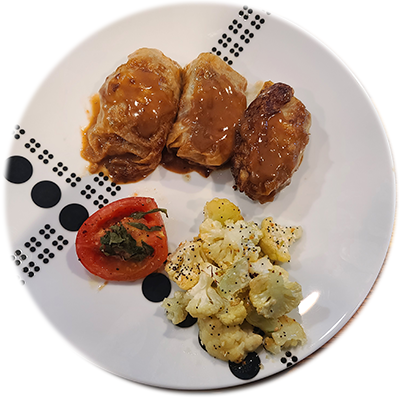I got this recipe for Swedish cabbage rolls from my late and much-missed friend, Bob Johnson, who learned it while working as a chef at the Waldorff Astoria in New York. There are lots of recipes for cabbage rolls online, but none quite match Bob’s. This is a little time-consuming, but the end product is well worth the effort.
The history of this dish dates back to at least the eighteenth century and King Karl XII’s military escapades in Moldava. The Swedish Spoon has many more details about this dish. Isabelle even reports that Sweden celebrates November 30, the death of King Karl XII, as “cabbage roll day.”
This recipe has several moving parts, some of which you can do simultaneously. For example, you can mix the filling while the cabbage boils. While the leaves cool, you can start the gravy by reducing the chopped-up unused cabbage bits. Once you’ve stuffed the rolls, you can strain the cabbage water and start reducing it while you brown the rolls. You get the idea. With a little planning, everything falls in place and the gravy is done just when need it, after you’ve browned the rolls. I’ve tried to keep the steps together, but to sequence things to encourage doing more than one thing at a time. If you do all the steps sequentially instead of multi-tasking, this could take half a day to prepare, so it’s worth the effort to plan ahead.
The recipe says to allow for an hour or prep time. This is kind off optimistic. It took me closer to 90 minutes the last time I fixed this, although to be fair about thirty minutes of that was waiting for the cabbage water to reduce. I spent the wait cleaning up, so it wasn’t totally wasted!
Finally, you can prepare this ahead of time except for the gravy. The rolls will keep at least overnight covered in the refrigerator, and the same is true of the reduced cabbage liquid. When you’re ready, while the oven pre-heats, combine the cabbage liquid, the stock, and the Kitchen Bouquet if using in a sauce pan and bring to a simmer. Once simmering, add the beurre manié, and simmer for an additional five minutes. Now you’re ready for the “finishing the rolls” step below.
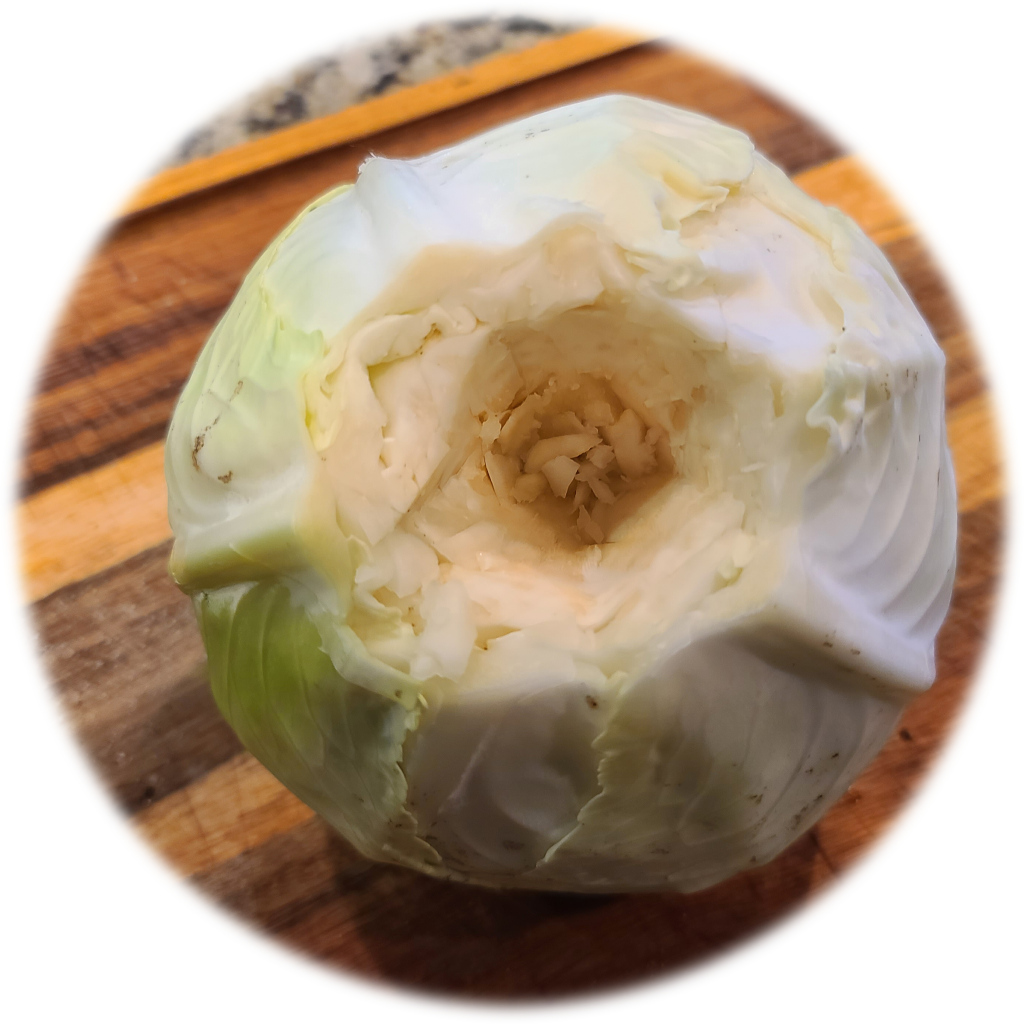
It’s important that you not rush the steps or take shortcuts. For example, it really helps to core the cabbage in two steps in order to dig out the entire core. See the photo at the left. This will make separating the leaves easier later. Also, when you boil the cabbage, start with the water at a rolling boil. When you put the cabbage in the water, wait to start the first five-minute countdown until after the water returns to a rolling boil. If you don’t boil the leaves the entire ten minutes, they will be too stiff to roll up. In fact, the inner leaves usually need an extra five minutes to be pliable.
The recipe suggests that you secure the rolls with a toothpick. This can be a pain, since you then need to take the toothpicks out before you serve them. I’ve found toothpicks are generally not necessary except for the occasional roll that comes apart when you brown them. If one does come apart, you can easily secure it with a toothpick once it’s cooled. As above, don’t rush browning them, and don’t crowd the pan.
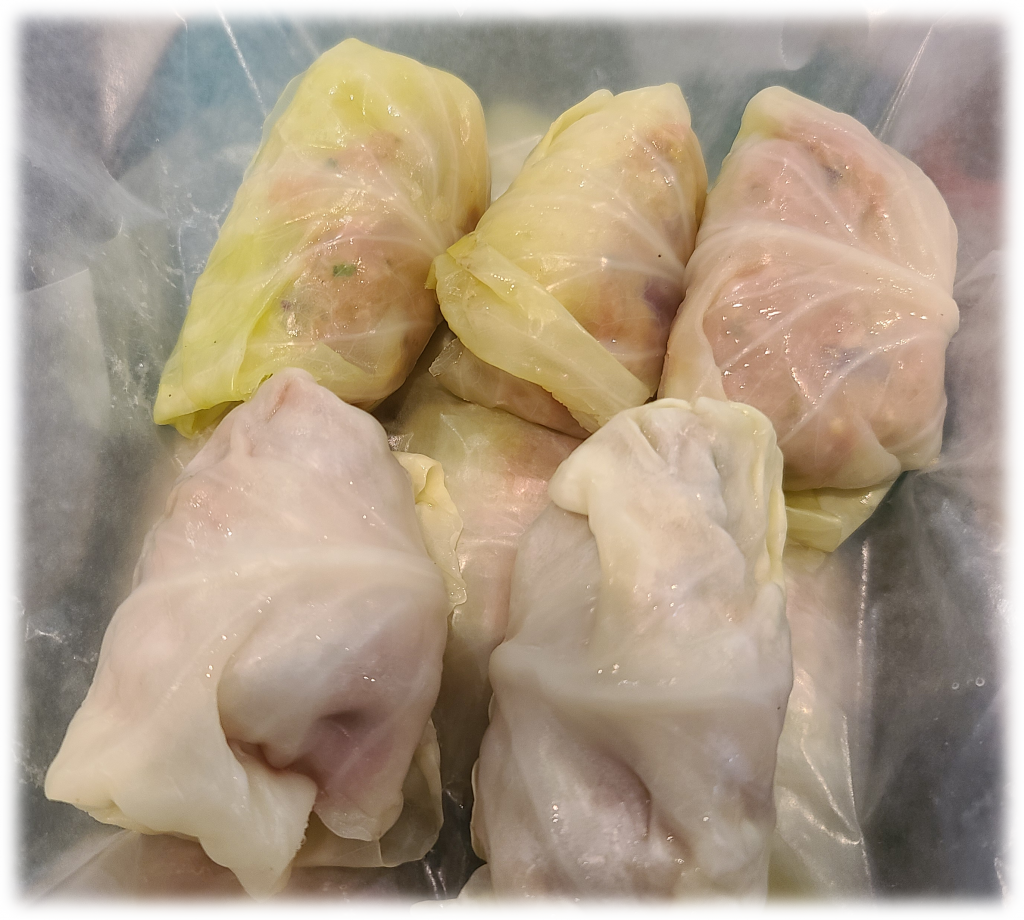
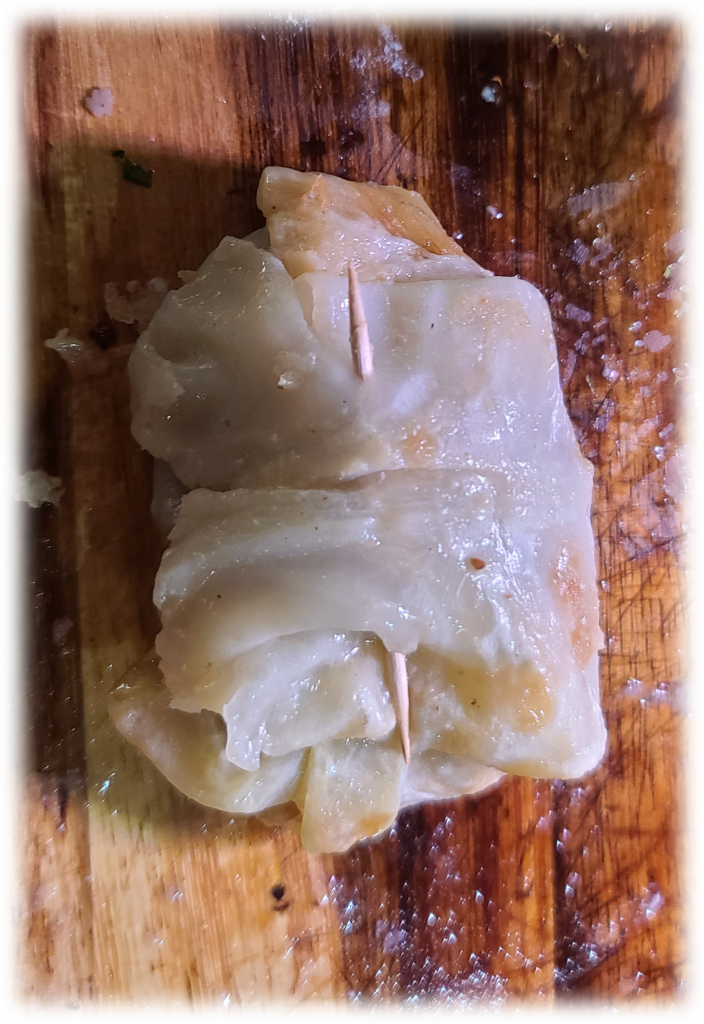
Here’s what the rolls look like fresh from the oven. I had 13 rolls total, but they wouldn’t fit in my covered casserole, so I used two pans to cook them. I could have used one 9×15 inch baking pan and covered it with aluminum foil, but I wanted a better looking dish for this photo. I also put the four rolls that I had to secure with toothpicks in the other pan.
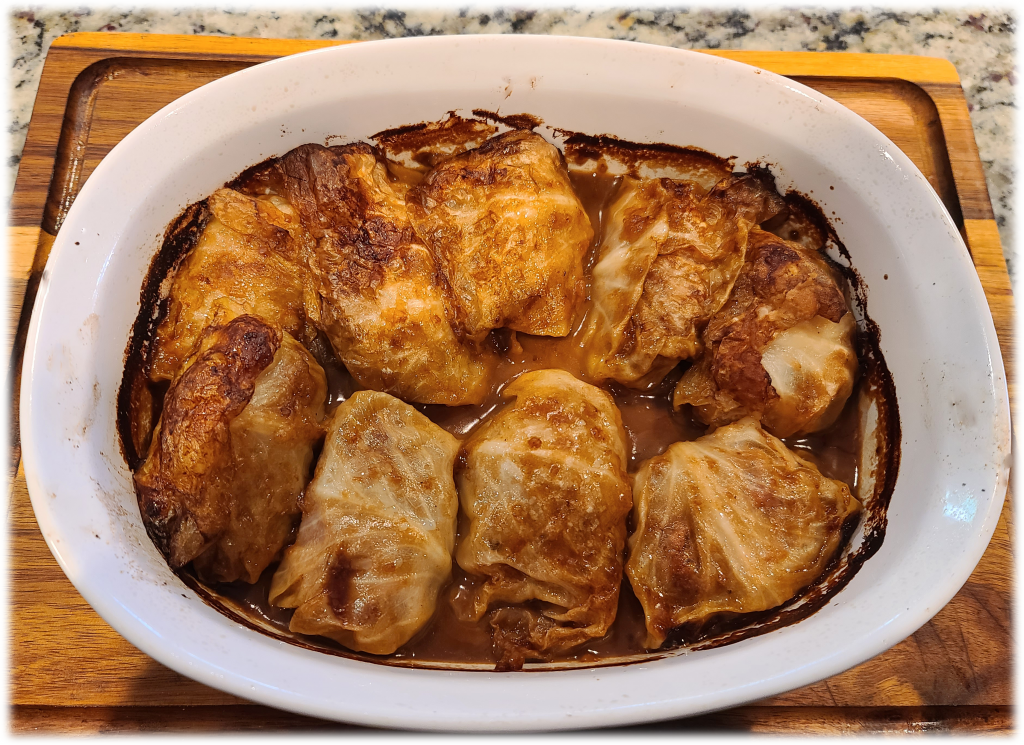
Almost any vegetable side dish goes with this as the main course. Well, except maybe Brussels sprouts, which might be a little too cabbage-y. I chose roasted cauliflower and tomatoes for the meal in the photo. The tomatoes are topped with salt and pepper and chiffonade of basil, while the cauliflower is seasoned with Not Just Bagel Seasoning. Let me know what you tried!
Kåldolmar
Equipment
- Stock pot
- Skillet
- Covered casserole or 9×15 baking dish covered with foil
Ingredients
For the rolls
- 1 pound ground lamb
- ¼ C oatmeal
- 3 cloves garlic chopped
- 1/2 medium onion diced
- 1 shallot diced
- Juice and peel from one lemon
- 1/2 teaspoon cardamom
- 1 teaspoon ground ginger
- 1 teaspoon coriander
- 2 teaspoons salt
- 1 teaspoon black pepper
- 1 egg
- 2 TBSP fresh parsley
- 1 head cabbage
For the gravy
- 1 TSP Kitchen Bouquet Optional
- 1 TBSP butter at room temperature for the beurre manié
- 2 TBSP flour for the beurre manié
- 1 C beef broth
Instructions
Stuffing the rolls
- Preheat oven to 350 degrees
- Fill stock pot half to two-thirds full with water and bring to boil
- Remove the core from the cabbage. This might require two steps to dig the entire core out. This will make pealing the cabbage easier later. Finely chop the core in a food processor and reserve.
- Put the head of cabbage in the boiling water, core-side down, cover, and boil for five minutes. After five minutes, you should be able to loosen the leaves, permitting the water to penetrate the head. Cover and boil another five minutes.
- While the cabbage boils, add the meat and remaining ingredients (but not those for the gravy!) to a bowl and mix with your hands.
- After ten minutes total boiling, you should be able to remove individual cabbage leaves from the pot using tongs. Put them on a cookie sheet or other pan to catch the water while they drain and cool. Save the water in the pot for later.
- The outer leaves may be too irregular and thin for wrapping. Don’t discard them—after they are cool, finely chop them and put them back in the brine, along with the finely chopped core from earlier. Bring the chopped cabbage and brine back to a boil and reduce by at least half while making the rolls.
- After they are cool enough to handle, de-vein the remaining leaves. To do this, carefully slice off the thick portion on the outer side at the bottomof the leaf so that it has uniform thickness and will roll up. You’ll want to have at least 12-14 leaves suitable for making rolls.
- To make the roll, place about 1/4 C of the meat mixture on a leaf and roll the bottom over the meat about half-way. Fold the sides of the leaf in, then complete the roll. It can be helpful to secure the roll by slipping a toothpick through the fold. If used, the toothpick shouldn't spear the roll; instead, it goes in-and-out of the fold laterally.
Browning the Rolls
- Place 1/8 inch of olive oil in the bottom a skillet and bring to medium-high heat. Dredge the rolls in flour (this is where the toothpick is helpful) and place them in the hot pan, seam-side down. Cook until brown, then turn over and cook the other side until brown.
- Drain rolls briefly on paper towels.
Making the Gravy
- Make the beurre manié by kneading together the room-temperature butter and flour.
- Strain the reduced cabbage/brine mixture, saving 1 cup of the liquid and discarding the solids. Return to pot and continue to reduce until about ½ C remains.
- Add 1 C beef broth and the Kitchen Bouquet to the simmering cabbage liquid.
- Whisk in about 1/4 of the beurre manié and continue to simmer until gravy thickens slightly—about five minutes. Add more beurre manié if sauce is too watery, but you don't want a thick gravy. You can save the unused beurre manié in the refrigerator for at least a couple of weeks and use it later. It's great for making pan sauces or even French sauces like Bechamel or Veloute.
Finishing the rolls
- Spray a 9×15 baking dish with PAM or other cooking spray
- Drizzle some gravy in the prepared baking dish–enough to just cover the bottom.
- Arrange the rolls in the baking dish, then top with the remaining gravy.
- Cover and cook at 350 degrees for 90 minutes.
- Remove from oven and let rest for 20-30 minutes.
- Serve over egg noodles, seasoned with butter and cilantro. Use a green vegetable such as Brussels sprouts or asparagus as a side dish.

